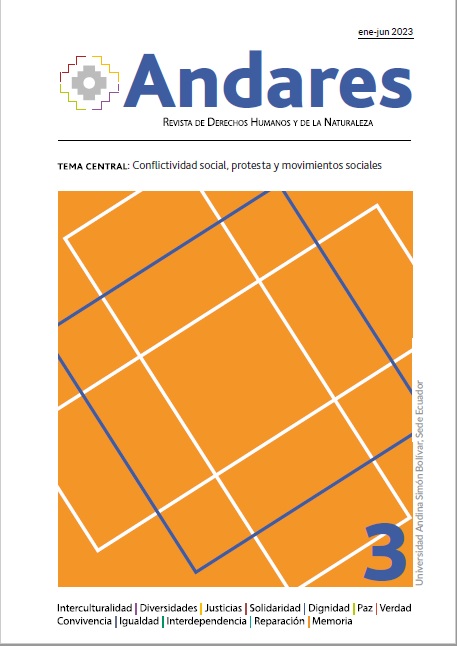¿Cómo han incidido los ciclistas tlaxcaltecas en la producción de un espacio urbano que permita el ejercicio del derecho a la movilidad?: Tipos y grado de incidencia de la participación ciudadana de los ciclistas en Tlaxcala72
DOI:
https://doi.org/10.32719/29536782.2023.1.7Palabras clave:
derecho a la movilidad, participación ciudadana, protesta, producción del espacio, movilidad urbana, acción colectiva, movimiento social, sociedad civil, incidenciaResumen
El presente artículo tiene como objetivo analizar la diversidad de actividades de los ciclistas urbanos en Tlaxcala en torno al espacio público y el derecho a la movilidad, específicamente la movilidad urbana sustentable, para categorizarlas y diferenciarlas entre acciones colectivas, de la sociedad civil o de movimientos sociales, así como para discutir su grado de incidencia en la producción de un espacio urbano que materialice el ejercicio de su derecho humano a la movilidad en los términos tutelados por la Constitución mexicana. Para lograr esto, en primera instancia se hace un recorrido histórico y contextual por el derecho a la movilidad, su actualización, la modalidad urbana sustentable en México y su relación con el derecho a la protesta. En un segundo momento, se desglosa el marco teórico para explicar y tipificar las actividades de los ciclistas. En un tercer apartado, se explica el contexto que da lugar a la participación de los ciclistas a cada una de las actividades que realizaron, en orden cronológico. Por último, se elabora una tabla para sintetizar y analizar las acciones a la luz de la teoría y se discute su grado de incidencia.
Descargas
Referencias
Álvarez, Lucía. “Ciudadanía y construcción de ciudadanía”. En La ciudad como cultura: Líneas estratégicas de política pública para la Ciudad de México, coordinado por Roberto Eibenschutz y Carlos Lavore, 25-46. Ciudad de México: Debate / Universidad Autónoma Metropolitana, 2017.
Bayat, Assef. “From ‘Dangerous Classes’ to ‘Quiet Rebels’: Politics of the Urban Subaltern in the Global South”. International Sociology 15, n.° 3 (2000): 533-57. https://doi.org/10.1177/026858000015003005.
Domaradzka, Anna. “Urban Social Movements and the Right to the City: An Introduction to the Special Issue on Urban Mobilization”. Voluntas 29 (2018): 607-20. https://bit.ly/3AZuav9.
Gobierno de México, y OPS México. Movilidad 4s para México: Saludable, segura, sustentable y solidaria. Plan de movilidad para una nueva normalidad. Ciudad de México: Gobierno de México / OPS México, 2020. https://bit.ly/3MTZ1Qs.
Harvey, David. Ciudades rebeldes: Del derecho a la ciudad a la revolución urbana. Madrid: Akal, 2013.
Isunza, Ernesto, y Felipe Hevia. Relaciones sociedad civil-Estado en México: Un ensayo de interpretación. Ciudad de México: Programa Interinstitucional de Investigación-Acción sobre Democracia, Sociedad Civil y Derechos Humanos, 2006.
Jasper, James. “Social Movement Theory Today: Toward a Theory of Action?”. Sociology Compass 4, n.° 11 (2010): 965-76. https://doi.org/10.1111/j.1751-9020.2010.00329.x.
Knox, Paul, y Steven Pinch. Urban Social Geography: An Introduction. Londres: Routledge, 2010.
Lichterman, Paul. “Civic Culture at the Grass Roots”. En The Blackwell Companion to the Sociology of Culture, editado por Mark Jacobs y Nancy Weiss, 383-97. West Sussex, UK: Wiley / Blackwell, 2016.
Melucci, Antonio. Vivencia y convivencia: Teoría social para una era de la información. Madrid: Trotta, 2001.
México. Decreto por el que se declara reformadas diversas disposiciones de la Constitución Política de los Estados Unidos Mexicanos, en materia de movilidad y seguridad vial. 18 de diciembre de 2020.
ONU. “Objetivos de Desarrollo Sostenible”. ONU. Accedido 6 de mayo de 2023. https://bit.ly/2qk9f28.
Pacione, Michael. “Concepts and Theory in Urban Geography”. En Urban Geography: A Global Perspective, editado por Michael Pacione, 18-34. Nueva York: Routledge, 2009.
Paredes, Juan Pablo. “Movilizarse tiene sentido: Análisis cultural en el estudio de movilizaciones sociales”. Psicoperspectivas 12, n.° 2 (2013): 16-26. https://bit.ly/3LZvKT9.
Pickvance, Chris. “From Urban Social Movements to Urban Movements: A Review and Introduction to a Symposium on Urban Movements”. International Journal of Urban and Regional Research 27, n.° 1 (2003): 102-9. https://bit.ly/3VClKDw.
Pizarro, Andrés. “Políticas integradas y sostenibles de movilidad: Revisión y propuesta de un marco conceptual”. Boletín FAL 323 (2013). https://bit.ly/3nsQ3jC.
Tenahua, Adolfo. “SESA Tlaxcala reporta al transporte público como foco de contagio de coronavirus”. Milenio. 29 de julio de 2020. https://bit.ly/3Mu9AZ9.







